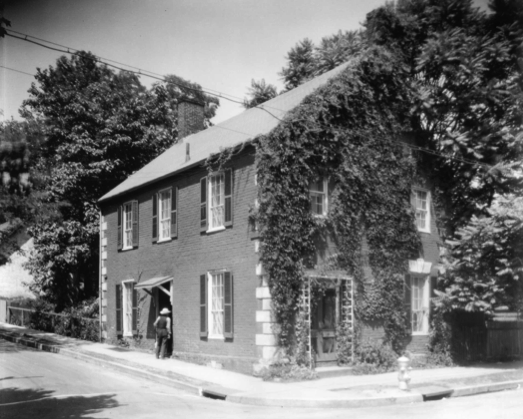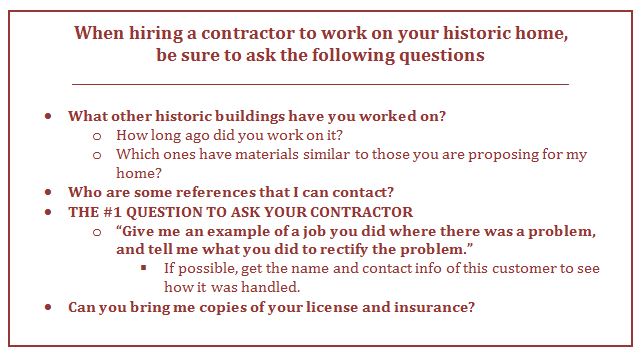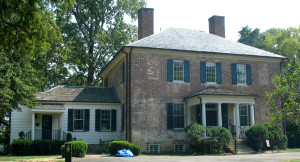Before Starting Work on Your Building
How Much Work Are We Talking About?
What are Your Project Expectations?

How Much Work Are We Talking About?
What are Your Project Expectations?
As owners of historic homes, what exactly are we protecting and preserving?
Fredericksburg’s historic buildings belong to the continuum of history spanning from the 18th century to the present day, and do not belong to a single period or style.
Change is an important part of the record, because tastes and techniques changed, and buildings have been expanded and even embellished over time.
The goal is to preserve the historic record (including changes made over time) of the forms, materials, and workmanship, as well as the underlying socioeconomic and cultural history of the town.
If you are investing a substantial amount of money into improving your home or another historic property, there is a chance that the work you are looking to have done might qualify for a few financial incentives that support the rehabilitation of older buildings. While these incentives won’t cover the entire cost of rehabilitation, they can help offset the financial burden of deferred maintenance on a historic property.
Learn more about historic rehabilitation tax credits available for Fredericksburg’s older building stock here.
If you are going to be doing a large renovation of your home or building an addition, consider hiring a professional architect. Their insight into design and the rhythm of buildings will be well worth the investment. An architect that is sensitive to historic homes will produce a better product if you yourself are historically minded. See the section, “Additions & Large Repairs” for more information on the design basics of larger projects.
You and your family will be looking at this work everyday, make sure it is the best it can be. Having two professional opinions, the architect and the contractor, can be invaluable.
It is best to hire a contractor or company that has substantial experience working with historic buildings. Historic buildings have different needs than buildings built today. The materials are different, the building systems are different, and if they are not treated as such, damage and a decrease in historic value can occur.
Contractors that have experience with older homes will know what resources to go to for the unique needs of historic homes. They have built connections with suppliers and craftspeople, and have years of experience working with the historic buildings.
Ask anyone doing work on your historic building for references, preferably references corresponding to projects dealing with historic buildings of similar age, materials, or style to your home. Are they familiar with the Secretary of the Interior’s Standards? (See link below) Good contractors will happily send you to see their work and talk to prior customers. How do their projects look 5, 10, 15 years later? Have they held up over time? Quality materials and good workmanship will last and should be considered when comparing bids.
Ask potential contractors about a job they did where there was a problem. What did they do to rectify the problem? Was the client happy with the outcome? Ask for the name and contact information of a prior client such as this. Everyone makes mistakes—it is how they fix them that matters the most.
Also ask for:
If a contractor is licensed, you can go to www.dpor.virginia.gov/LicenseLookup/ to see how long he or she has had a license, when it expires, if there have been any complaints, etc. You can also file a complaint if you have a problem with a contractor.
It is illegal for someone to do work on your home without a license and unwise for you to hire him or her without one.
Before hiring a contractor it is your responsibility to do your research to know what you do and do not want.
Once you hire a quality contractor and begin work on a project let him or her do their job, but it is perfectly acceptable to ask questions. A good contractor should have no problem explaining their work or processes to a homeowner.
Online Resources
Secretary of the Interior’s Standards for Rehabilitation codified as 36 CFR 67
http://www.nps.gov/tps/standards/rehabilitation.htm
Virginia Department of Professional and Occupational Regulations
http://www.dpor.virginia.gov/consumers/

Decide on what you expect before meeting with contractors and salespeople so you have a firm answer for their questions and cannot be pushed around. Hold true to your project vision. Such planning will also reduce miscommunication.
Do not allow anyone to rush you through the planning process of a project—this is your home.
But remember to be realistic. You are sure to be disappointed if you are not.
What is most important to you about the work you are planning to do on your home? What is your goal?
A DISTINCT LOOK
PRICE
QUALITY
Online Resources
Secretary of the Interior’s Standards for Rehabilitation codified as 36 CFR 67
http://www.nps.gov/tps/standards/rehabilitation.htm
Preservation Brief 18—Rehabilitating Interiors in Historic Buildings: Identifying and Preserving Character-Defining Elements by Lee H. Nelson, FAIA
http://www.nps.gov/tps/how-to-preserve/briefs.htm
One person’s trash is another’s treasure.
The light fixture you no longer want may be exactly what someone else is looking for. You may need just one more drawer pull to make a set.
Architectural salvage yards and stores such as Habitat ReStore are just what you need.
*Re-use responsibly. HFFI does not condone the stripping of historic buildings for the benefit of architectural salvage sales.

As owners of historic homes, what exactly are we protecting and preserving?
Fredericksburg’s historic buildings belong to the continuum of history spanning from the 18th century to the present day, and do not belong to a single period or style.
Change is an important part of the record, because tastes and techniques changed, and buildings have been expanded and even embellished over time.
The goal is to preserve the historic record (including changes made over time) of the forms, materials, and workmanship, as well as the underlying socioeconomic and cultural history of the town.
Understanding the contributions of your property to the historic record and its “character-defining features” are the first and most critical steps in being a good steward of it.
Start with the neighborhood or block: What do you see?
Now look closer at the details.
Exterior alterations that change a character-defining feature of a building are discouraged; however, creative solutions may be possible. For example, rather than infilling an existing window, exterior shutters may be closed, the sash left in place, and finishes added to close up the window from inside (a “blind window”).
Should you choose to add on to your historic home, these steps are critical:
Maintenance is critical to protecting any building. There is no such thing as a maintenance-free building, and keeping the water out, broadly speaking, requires constant vigilance, from the rooftop to the foundation. In all of its forms, liquid, gas, and solid state, water is perhaps the largest contributor to decay in homes today. Anything that compromises a building’s ability to keep the water out—whether it’s failing roofing, clogged gutters, or ill-fitting or broken windows—needs to be addressed in a timely manner. Typically, wood surfaces are protected by paint, which needs to be maintained.
Materials and finishes have life spans, and there are instances when replacing materials is appropriate. It is important to replace with like materials, particularly on primary facades and main interior rooms, accurately reflecting dimensions and details. It is critical to use tradespeople skilled in the particulars of the material being replaced, especially when the material (slate roofing, wood roofing shakes) is no longer widely used.
Replacing some features can be more nuanced.
Online Resources
Excellent Website – Highly Recommended
“Walk Through,” A step-by-step guide to identify a building’s character—National Park Service
http://www.nps.gov/tps/education/walkthrough/
Preservation Brief 14 – New Exterior Additions to Historic Buildings: Preservation Concerns by Anne E. Grimmer and Kay D. Weeks
http://www.nps.gov/tps/how-to-preserve/briefs.htm
Preservation Brief 17—Architectural Character—Identifying the Visual Aspects of Historic Buildings as an Aid to Preserving their Character by Lee H. Nelson, FAIA
http://www.nps.gov/tps/how-to-preserve/briefs.htm
Historic Fredericksburg Foundation, Inc.
1200 Caroline Street
Fredericksburg, VA 22401
540-371-4504
office@hffi.org
